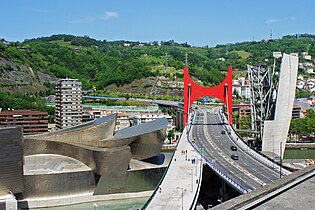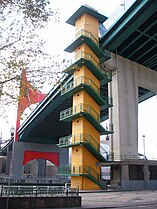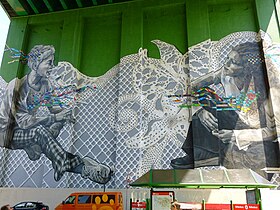Puente La Salve
Coordinates: 43 ° 16 '10 " N , 2 ° 55' 55" W.
| Puente La Salve | ||
|---|---|---|
| use | Road bridge | |
| Crossing of | Ría de Bilbao | |
| place | Bilbao | |
| construction | Cable-stayed bridge | |
| overall length | ≈ 244 m | |
| width | ≈ 26 m | |
| Number of openings | six | |
| Longest span | ≈ 76 m | |
| Clear height | 23.5 m | |
| start of building | 1968 | |
| opening | January 9, 1972 | |
| planner | Juan Batanero | |
| location | ||
|
|
||
The Puente La Salve ( Basque Salbe Zubia ), officially the Puente de los Príncipes de España until 2016 , is a road bridge over the Ría de Bilbao in Bilbao in the Basque Country Autonomous Community in Spain .
description
The Puente La Salve crosses the river at a height of 23.5 m and connects the Alameda de Recalde in the Abando district on the south side with the Avenida Maurice Ravel (connecting road BI-625), which runs halfway up the slope between the Matiko and Castaños districts on the north side the Artraxanda - La Salve tunnel .
The Guggenheim Museum Bilbao, which is largely clad in titanium sheet , stands directly next to and below it. Two scaffolding towers, partly clad with the same titanium sheet, next to the bridge (Torre de La Salve) serve as a stairway connection between the bridge and the museum. The work Arcos rojos / Arku gorriak (Red Arches) by Daniel Buren transformed the original pylon of the bridge into a contrast to the silver-gray titanium sheet of the museum that characterizes the cityscape.
The total of about 244 m long and 26 m wide, single-hip cable - stayed bridge has an approx. 76 m wide main opening over the river, which is followed by an opening on the north side over the Avenida de la Universidades, which runs along the bank . On the south side there is the side opening for the stay cables on the other side of the pylon as well as three other openings with which the bridge is connected to the streets and the pedestrian ramp that branches off to the museum forecourt.
The bridge stands on simple rectangular reinforced concrete - pillars , which are stiffened by cross beams underneath the deck. The pylon, enveloped by the red arches , consists of two steel stems connected by a crossbeam. Only the distinctive cable saddles for the stay cables are still visible. The deck girder consists of a dark green steel plate beam construction . The bridge has two lanes to the south and three lanes to the north as well as wide sidewalks on both sides.
On the northern bank there are two ocher-yellow rectangular stair towers with external, matt green painted stairs that connect the carriageway level with the embankment, which is five floors below. One of the towers has an elevator.
The high wall of the northern abutment , originally only structured with pilaster strips, was decorated in 2012 by Veronica Werckmeister (lead artist) with the 990 m² mural A key - Giltza bat (A key) , which shows two women engaged in a discussion.
history
The cable-stayed bridge, designed by Juan Batanero, was built between 1968 and 1972 to solve the traffic problems in the northern districts of Bilbao. It was inaugurated on January 9, 1972 and named in honor of Juan Carlos I and his wife Sophia of Greece after their title, Príncipe de España , created under General Francisco Franco .
It was the first cable-stayed bridge in Spain. At that time it still had a road branching off to Mazarredo Zumarkales Street, which ran along the high bank . When the Guggenheim Museum was built between 1993 and 1997, efforts were made to incorporate the bridge into the museum's design. Four years later, the junction was redesigned into a wide pedestrian ramp to the north forecourt of the museum. At the same time, the branch to the Artraxanda - La Salve tunnel was built on the northern side .
Daniel Buren, whose work Arcos rojos / Arku gorriak was executed in 2007 , won the competition that the museum organized in connection with its tenth anniversary in order to integrate the bridge even better into the overall concept of the museum .
In February 2016, the bridge's original name, reminiscent of Franquism , was changed to Puente La Salve .
In 2017 the Red Arches were completely renovated.
Web links
Individual evidence
- ↑ Puente de La Salve on BilbaoTurismo.net (the correct name is Puente La Salve , as can be seen from the name tag on the bridge)
- ↑ a b Arcos rojos / Arku gorriak - Daniel Buren on Guggenheim-bilbao.eus
- ↑ The dimensions are based on measurements in Google Earth
- ↑ A key - Giltza asked to muralismopublico.com
- ↑ Puente de la Salve, su historia y curiosidades on debilbaopues.com
- ↑ Escultura Arcos rojos on Bilbaopedia.info
- ↑ El Ayuntamiento de Bilbao cambia el nombre de otras tres calles en aplicación de le Ley de Memoria Histórica on Bilbao.eus
- ↑ Julita Berrojalbiz da nombre desde este martes a una calle en Bilbao on ElMundo.es
- ↑ El Guggenheim Bilbao reinaugura los 'Arcos Rojos' de Daniel Buren, tras completar las obras de conservación on eldiario.es/norte








